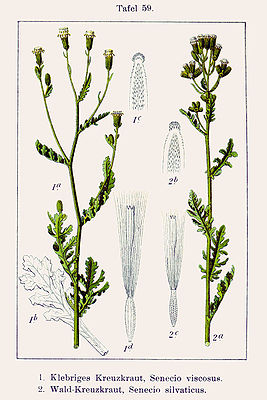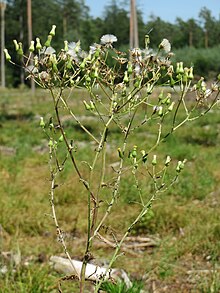Forest ragwort
| Forest ragwort | ||||||||||||
|---|---|---|---|---|---|---|---|---|---|---|---|---|

Illustration of the common ragwort ( Senecio sylvaticus , right); left the sticky ragwort ( Senecio viscosus ) |
||||||||||||
| Systematics | ||||||||||||
|
||||||||||||
| Scientific name | ||||||||||||
| Senecio sylvaticus | ||||||||||||
| L. |
The Senecio sylvaticus ( Senecio sylvaticus ) is a plant from the genus of Senecio ( Senecio ) in the family of the daisy family (Asteraceae).
features
The forest ragwort is an annual herbaceous plant that reaches heights of 15 to 50 cm and is bald to scattered woolly hair. Unlike the similar sticky groundwort ( Senecio viscosus ), it is neither glandular-sticky nor does it smell unpleasant. The leaves are pinnate and have serrated leaflets .
12 to 24 flower heads stand together in a loosely paniculate inflorescence . The cup-shaped partial inflorescences have a diameter of 5 mm. On the outside there are one to eight yellow ray florets , they are usually rolled back, these can also be missing. Inside are the yellow, radially symmetrical tubular flowers . Flowering time is from July to September.
The fruits are achenes .
The number of chromosomes is 2n = 40.
Occurrence
This species occurs in large parts of Europe, in Germany it is found scattered to widespread. Its original distribution area includes Madeira, Portugal, Spain, France, Great Britain, Ireland, Italy, Belgium, the Netherlands, Germany, Switzerland, Austria, the Czech Republic, Poland, Slovakia, Norway, Sweden, Finland, the Baltic States, Hungary, Serbia, Slovenia , the Balkans, Bulgaria, Romania, Ukraine and Turkey. In the Azores it is a neophyte, in Belarus, Russia and Moldova the originality is questionable.
The forest ragwort mainly inhabits clearcuts, but also light deciduous and mixed forests as well as forest edges and occurs at altitudes of 1800 m. It is a character species of the order Atropetalia and occurs particularly in societies of the associations Epilobion angustifolii or Atropion.
This species is a neophyte in North America , Argentina, Chile, New Zealand, Hawaii, and the Azores .
ecology
The species is a nitrification indicator and a humus eater.
ingredients
The plant is considered poisonous.
literature
- Gunter Steinbach (Ed.): Wildflowers (Steinbach's natural guide). Mosaik Verlag GmbH, Munich 1996.
Individual evidence
- ↑ a b c Erich Oberdorfer : Plant-sociological excursion flora for Germany and neighboring areas . With the collaboration of Angelika Schwabe and Theo Müller. 8th, heavily revised and expanded edition. Eugen Ulmer, Stuttgart (Hohenheim) 2001, ISBN 3-8001-3131-5 , pp. 957 .
- ↑ a b Werner Greuter (2006+): Compositae (pro parte majore). - In: W. Greuter & E. von Raab-Straube (eds.): Compositae. Euro + Med Plantbase - the information resource for Euro-Mediterranean plant diversity. Datasheet Senecio sylvaticus In: Euro + Med Plantbase - the information resource for Euro-Mediterranean plant diversity.
- ↑ Senecio sylvaticus in the Germplasm Resources Information Network (GRIN), USDA , ARS , National Genetic Resources Program. National Germplasm Resources Laboratory, Beltsville, Maryland. Retrieved June 8, 2016.
Web links
- Forest ragwort. In: FloraWeb.de.
- Forest ragwort . In: BiolFlor, the database of biological-ecological characteristics of the flora of Germany.
- Profile and distribution map for Bavaria . In: Botanical Information Hub of Bavaria .
- Senecio sylvaticus L. In: Info Flora , the national data and information center for Swiss flora . Retrieved June 8, 2016.
- Area map at "Den virtuella floran" (Swedish)
- Thomas Meyer: Greiskraut data sheet with identification key and photos at Flora-de: Flora von Deutschland (old name of the website: Flowers in Swabia )
- Entry in the Flora of North America. (engl.)
- Entry at GRIN.


